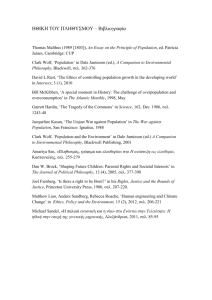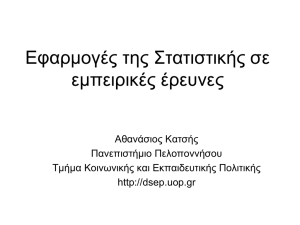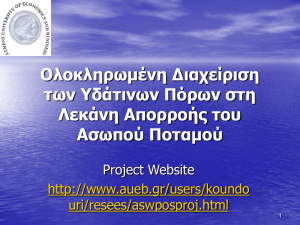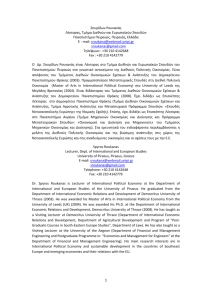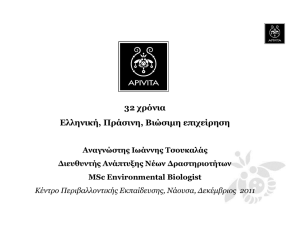Computing Systems and Applications
advertisement
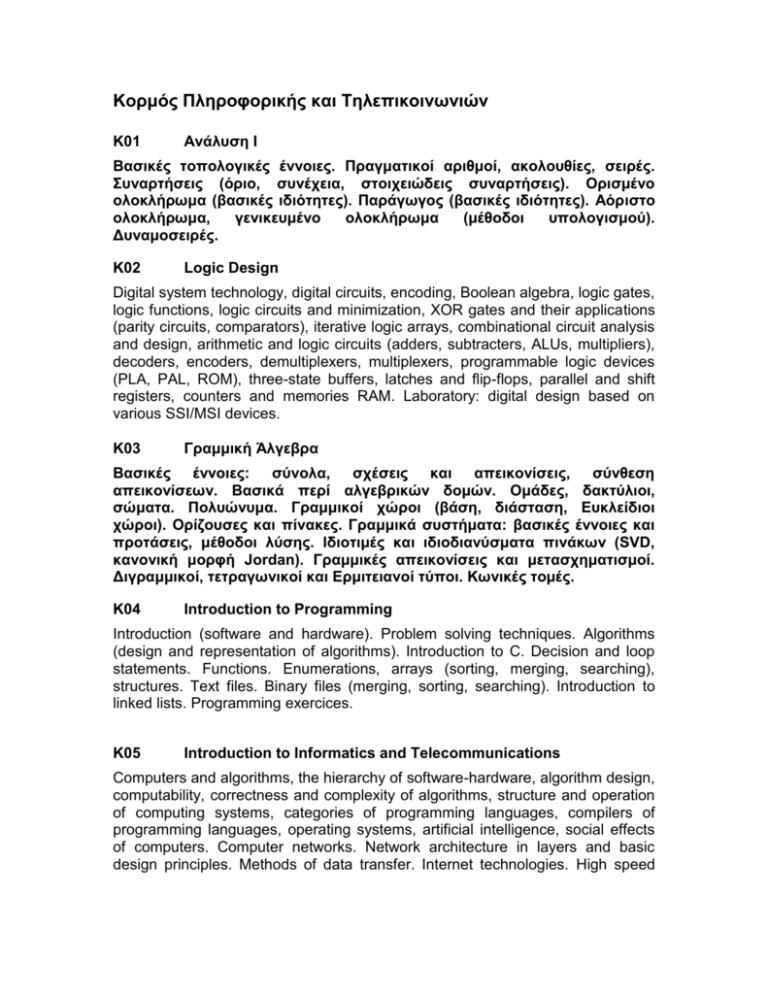
Κορμός Πληροφορικής και Τηλεπικοινωνιών Κ01 Ανάλυση Ι Βασικές τοπολογικές έννοιες. Πραγματικοί αριθμοί, ακολουθίες, σειρές. Συναρτήσεις (όριο, συνέχεια, στοιχειώδεις συναρτήσεις). Ορισμένο ολοκλήρωμα (βασικές ιδιότητες). Παράγωγος (βασικές ιδιότητες). Αόριστο ολοκλήρωμα, γενικευμένο ολοκλήρωμα (μέθοδοι υπολογισμού). Δυναμοσειρές. Κ02 Logic Design Digital system technology, digital circuits, encoding, Boolean algebra, logic gates, logic functions, logic circuits and minimization, XOR gates and their applications (parity circuits, comparators), iterative logic arrays, combinational circuit analysis and design, arithmetic and logic circuits (adders, subtracters, ALUs, multipliers), decoders, encoders, demultiplexers, multiplexers, programmable logic devices (PLA, PAL, ROM), three-state buffers, latches and flip-flops, parallel and shift registers, counters and memories RAM. Laboratory: digital design based on various SSI/MSI devices. Κ03 Γραμμική Άλγεβρα Βασικές έννοιες: σύνολα, σχέσεις και απεικονίσεις, σύνθεση απεικονίσεων. Βασικά περί αλγεβρικών δομών. Ομάδες, δακτύλιοι, σώματα. Πολυώνυμα. Γραμμικοί χώροι (βάση, διάσταση, Ευκλείδιοι χώροι). Ορίζουσες και πίνακες. Γραμμικά συστήματα: βασικές έννοιες και προτάσεις, μέθοδοι λύσης. Ιδιοτιμές και ιδιοδιανύσματα πινάκων (SVD, κανονική μορφή Jordan). Γραμμικές απεικονίσεις και μετασχηματισμοί. Διγραμμικοί, τετραγωνικοί και Ερμιτειανοί τύποι. Κωνικές τομές. Κ04 Introduction to Programming Introduction (software and hardware). Problem solving techniques. Algorithms (design and representation of algorithms). Introduction to C. Decision and loop statements. Functions. Enumerations, arrays (sorting, merging, searching), structures. Text files. Binary files (merging, sorting, searching). Introduction to linked lists. Programming exercices. Κ05 Introduction to Informatics and Telecommunications Computers and algorithms, the hierarchy of software-hardware, algorithm design, computability, correctness and complexity of algorithms, structure and operation of computing systems, categories of programming languages, compilers of programming languages, operating systems, artificial intelligence, social effects of computers. Computer networks. Network architecture in layers and basic design principles. Methods of data transfer. Internet technologies. High speed networks, mobile and personal networks. Signals and systems, time and frequency domain, sampling, signal and image compression. Κ06 Ανάλυση ΙΙ Συναρτήσεις πολλών μεταβλητών, μερικές παράγωγοι, διαφορικό. Σειρές Taylor. Πεπλεγμένες συναρτήσεις. Ακρότατα συναρτήσεων με πολλές μεταβλητές. Πολλαπλά ολοκληρώματα. Επικαμπύλια ολοκληρώματα. Στοιχεία διανυσματικής ανάλυσης (θεωρήματα Stokes, Gauss και Green). Κ07 Φυσική Διατήρηση της ενέργειας. Ισχύς. Ορμή και ώθηση. Περιστροφική κίνηση. Δυναμική της περιστροφικής κίνησης. Βαρύτητα. Περιοδική κίνηση. Πρώτο θερμοδυναμικό αξίωμα. Δεύτερο θερμοδυναμικό αξίωμα. Μηχανικά κύματα. Επαλληλία και κανονικοί τρόποι ταλάντωσης. Ήχος. Σχετικιστική Μηχανική. Φωτόνια, ηλεκτρόνια και άτομα. Κυματική φύση των σωματιδίων. Κβαντική μηχανική. Δομή των ατόμων. Μόρια και συμπυκνωμένη ύλη. Πυρηνική φυσική. Φυσική σωματιδίων και Κοσμολογία. Κ08 Data Structures Data Structures Introduction. The Abstract Data Type (ADT). The ADT array, record, set and string. Stacks, Recursion, Queues, Lists, Trees (binary and binary search trees), AVL Trees. Graphs. Applications. Κ09 Discrete Mathematics Introduction to set theory, proof methods, basics of enumerative combinatorics, discrete probability, recurrence relations, introduction to graph theory, asymptotic complexity, introduction to number theory. Κ10 Object-Oriented Programming Introduction to object oriented programming concepts. The C++ programming language: basic language constructs, namespaces, overloading, objects and classes, inheritance and composition, templates, abstract classes, exception handling, introduction to the standard library. Introduction to the STL and generic programming. Overview of Java. Other object oriented programming languages. An introduction to the theory of objects. Κ11 Ηλεκτρονική και Εφαρμογές στην Πληροφορική Εισαγωγικές γνώσεις από τη θεωρία Ημιαγωγών, επαφή p-n, δίοδοι (λειτουργίες, βασικά κυκλώματα), τρανζίστορ επαφής, πύλες, Flip-Flop, Transistor FET, JFET, MOSFET, CMOS κλπ, εφαρμογές. Κ12 Numerical Analysis Round off error analysis. Numerical solution of nonlinear equations (Fixed point, Newton-Raphson). Numerical solution of linear systems (Direct Methods (Gaussian Elimination, Gauss-Jordan), Iterative methods (Jacobi, Gauss-Seidel, SOR)). Numerical methods for computing eigenvalues and eigenvectors. Interpolation. Least Squares method. Numerical Differentiation. Numerical Integration. Numerical solution of ordinary Differential equations. Κ13 Fields and Waves Electricity: electric charge and potential, capacitors and dielectrics, current, resistance and electromotive force, continuous current circuits, moving charges and magnetic field, self inductance and mutual inductance, alternative current, RL-C circuits. Electromagnetism: Fields and Potentials. Flux and Circulation. Maxwell equations. Electromagnetic fields and sources. Maxwell Integral equations (Ampere, Faraday and Gauss laws). Wave equation of Electromagnetic field. Phasors. Limit conditions. Poynting vector. Plane waves. Polarization. Reflection and Diffraction of plane waves. Radiation. Fundamental Parameters of Antennas. Type of Antennas. Linear wire antennas. Optics: Light. Speed of light. Index of refraction. Fermat’s principle of least time. Huygen’s Construction. Snell’s law. Dispersion of light. Dispersion and refraction examples. Birefringence. Polarization and polarizers. Malus’ law. Brewster’s law. Coherence of light Geometric or ray optics. Laws of reflection and refraction, Total internal reflection, critical angle. Prisms. Guided waves optics. Fibers. Mirrors. Planar, concave and convex spherical mirrors, the mirror’s equation, magnification, sign conventions. Lenses. Thin lenses. Paraxial approximation and ray tracing. Objects and images, the lens equation, sign conventions, the lensmaker’s formula, compound lens system, meniscus. Optical aberrations, chromatic and monochromatic aberrations. Optical Instruments. Multiple lenses, the eye, magnifiers, microscopes, telescopes, the camera. Interference. Constructive and destructive interference. Double slit. Multiple slits. Single slit with finite width. Diffraction. Near field (Fresnel) diffraction. Far field (Fraunhofer) diffraction. Bragg’s law. Diffraction grating. Resolution of an aperture and a grating. Photon, the quantum of light. Κ14 Πιθανότητες και στοιχεία Στατιστικής Αξιώματα πιθανότητας. Δεσμευμένη πιθανότητα και στοχαστική ανεξαρτησία. Τυχαίες μεταβλητές, συναρτήσεις κατανομής και πυκνότητας πιθανότητας. Κατανομή συνάρτησης τυχαίας μεταβλητής. Ροπές και ειδικότερα μέση τιμή και τυπική απόκλιση. Βασικές διακριτές και συνεχείς κατανομές. Προσέγγιση του δειγματικού μέσου από τον θεωρητικό μέσο και της κατανομής αυτού από την κανονική κατανομή. Εκτίμηση παραμέτρων και έλεγχος στατιστικών υποθέσεων. Κ15 Computer Architecture Ι Technology, performance and cost of computer systems, fundamental instruction set architectures, operands, memory organization (big endian, little endian and address alignment), addressing modes, instruction set encoding, operationinstruction types, levels of instruction representation, compilation from C language to Assembly and machine language, stack implementation, RISC and CISC architecture examples, the MIPS instruction set architecture, simple RISC datapath design, memory hierarchy, caches, virtual memory, interfacing processors and I/O devices, busses, interrupts, direct memory access. Laboratory: Assembly language programming for Intel 80x86 and MIPS (use of the SPIM simulator). Κ16 Communication Networks Introduction to the basic concepts and technologies of communication networks. Internet: architecture, addresses, routing and transport protocols. Local area networks: shared-medium multiple-access algorithms, performance evaluation, technologies, Ethernet. Asynchronous Transfer Mode (ATM): architecture, routing, end-to-end services. Data link layer and retransmission protocols. Congestion control and flow control mechanisms in the Internet. Methods for performance evaluation of networks. Κ17 Algorithms and Complexity Efficiency, Analysis and Order. Solving Recurrences. The Master Method. Heaps and Priority Queues, Binary Trees, Hashing, Union and Find, the Heapsort Algorithm. Elementary Graph Algorithms, Breadth-First Search, DepthFirst Search, Connected Components. The Divide and Conquer Approach, Merge Sort, Quick Sort. Greedy Algorithms, Minimum Spanning Trees, Prim’s and Kruskal’s Algorithms, Shortest Paths in Graphs, the Fractional Knapsack Problem, the Activity-Selection Problem. Dynamic Programming, the 0-1 Knapsack Problem. The Backtracking Technique, the n-Queens Problem. Decision Problems, the classes P and NP. NP-Complete and NP-Hard Problems. K18 Implementation of Database Management Systems Introduction to Database Management Systems, differences from File Management Systems, physical characteristics of external storage units (mostly disks), data organization on disks, the concept of a file, buffer management, primary file organizations, secondary file organizations, static and dynamic data structures, ISAM, B+ trees, static and dynamic hashing, external file sorting, relational algebra, processing of relational-algebra operators and corresponding algorithms, processing cost according to the type of index used, optimization of relational algebra queries, the concept of transaction, concurrency control, crash recovery. Κ19 Signals and Systems Basic definitions, classification and characterization of signals, causality, BIBO stability, linear systems, input-output, convolution, differential equations and difference equations, Fourier series, Fourier transform, Laplace transform, Bode diagrams. Κ20 Mathematics for Computer Science and Telecommunications The course consists of two parts. The topics of the first part include proof techniques, with emphasis on induction and existence proofs such as diagonalization; probabilistic analysis and techniques; techniques for the design and analysis of algorithms; cryptography and number theory; polynomials; elementary graph theory. The topics of the second part include differential equations and complex analysis. Κ21 Theory of Computation Countable sets, diagonalization, regular languages, finite automata, context-free languages, pushdown automata, Turing machines, recursive and recursively enumerable languages, undecidability, introduction to complexity theory, NPcompleteness. Κ22 Introduction to Communication Systems Elements of the Fourier transform and probability theory, Gaussian probability density function, introduction to stochastic processes, signal communication system, analog communication systems (AM FM), frequency multiplexing, effect of noise on analog communication systems, digital signal transmission through additive white Gaussian noise (AWGN) channel, optimum receiver for digitally modulated signals in AWGN (optimum demodulation and optimum detection), MPCM, M-QAM MFSK, comparison of digital signal transmission systems,channel capasity, digital coding of analog signal, quantization, PCM, DPCM Comparison of analog signal transmission systems. Κ23 Operating Systems Introduction to Operating Systems and components of computing systems. Process services, system programs, calls and methods for their implementation. Creation and management of processes. CPU scheduling and multiprogramming. Critical section problem, interprocess communication, semaphores, monitors, and shared segments. Memory hierachy, main memory and storage management. Paging, segmentation, swapping, virtual memory. Paging methods, allocation of frames, thrashing, and working set principles. Services of file systems, organization of files and/or I/O devices. Disk unit management and scheduling of disk requests. I/O interfaces for diverse types of long-term memory devices. Protection of operating system resources through access matrices. Security, authentication and various types of threats. Elements of Solaris/Linux operating systems and outline of distributed oeprating systems. Κ24 System Programming Introduction to Unix. Basic commands. Permissions. I-nodes. Interaction with the C shell. Auxiliary programs. Bourne shell programming. C programming for error handling, process creation and termination, signal handling, low-level input/output, interprocess communication through pipes and sockets (stream and datagram in the Internet and Unix domains). System V interprocess communication through message queues, shared memory and semaphores. Thread programming. Thread creation and termination. Thread synchronization. Mutexes and condition variables. File system management. K25 Software Development Extensive implementation of software systems, based on the contents of other courses, in two consecutive phases: a) Implementation of a simplified form of various internal layers of a Database Management System: block and record organization on disk, a static data structure on a file on disk (e.g., static hash table), a dynamic data structure on a file on disk (e.g., B+ tree), system catalogs, query processing for a simple database query language. b) Implementation of an application on top of some commercial Database Management System or the Internet or software based on some other technology. Κ26 Practical Training In the fourth year of our undergraduate program, the students participate in the program “PRACTICAL TRAINING OF STUDENTS” which is funded by the Ministry of Education. The Practical Training can substitute Undergraduate Thesis I or II (after consulting with the Scientific Advisor). Κ27 Undergraduate Thesis Ι Κ28 Undergraduate Thesis ΙΙ Theoretical Computer Science Courses ΘΠ01 Principles of Programming Languages History of Programming languages. Syntax and semantics. Data types, scoping, procedures, argument passing methods, procedure implementation. Basic categories of programming languages: imperative, object-oriented, logic, functional, parallel (main characteristics of each category and presentation of the main languages). Theoretical issues in programming languages. Techniques for transforming and optimizing programs. Proving program correctness using logic (Floyd-Hoare logic). Un-typed Lambda Calculus: conversions, normal forms, Church-Rosser theorem, expressive power, applications in programming languages. Typed Lambda Calculus. Theory of types and type-checking. ΘΠ02 Numerical Linear Algebra Inroduction. Round off error analysis. Direct methods for solving linear systems (elimination methods, factorization). Iterative methods for solving linear systems, Semi-Iterative methods. The Conjugate Gradient method. Numerical computation of eigenvalues and eigenvectors: iterative methods (Power method), Transformation methods (Jacobi, Givens, Householder, LR, QR). Introduction to the numerical solution of Partial Differential equations. ΘΠ03 Computer Graphics I Introduction, graphics output pipeline, graphics input and output devices. Scanconversion algorithms for lines, polygons, circles and conic sections. Anti-aliasing techniques. RasterOp. 2D and 3D affine transformations, homogeneous coordinates, composition of transformations. Window-to-viewport transformations. Line and polygon clipping algorithms in 2D and 3D. Projections. Hidden surface elimination principles. Basic illumination. Colour representation. Parametric curves and surfaces (basics). ΘΠ04 Parallel Systems General Introduction on parallel programming, parallel architectures and measures of performance. Classification of Parallel architectures and in depth examination of SIMD and MIMD (shared memory, distributed memory) architectures. Parallel programming in the message passing model with MPI laboratory and SIMD with Blitzen. Principles of shared memory programming. Parallel algorithms for array processing, sorting, searching for the above architectures. Calculation of parallel complexity (processing and communication). ΘΠ05 Κρυπτογραφία Εισαγωγικά: Στοιχεία θεωρίας πολυπλοκότητας, αλγεβρικών δομών, θεωρίας αριθμών, πιθανοτήτων, αλγεβρικών αλγορίθμων. Έννοια της ασφάλειας, απόκρυψη μυνήματος, κρυπτογραφικά πρωτόκολλα, κρυπτανάλυση και επιθέσεις. Τυχαίες και ψευδο-τυχαίες ακολουθίες ψηφίων. Μονόδρομες (one-way) συναρτήσεις και συναρτήσεις κρυφής εισόδου (trapdoor). Απόκρυψη και επιθέσεις σε πρωτόκολλα κρυφού/ιδιωτικού και δημόσιου κλειδιού (πχ. RSA, Diffie-Hellman, El Gamal). Τεχνικές βασισμένες στη θεωρία κωδίκων, την συνάρτηση διακριτού λογαρίθμου, τη δυσκολία παραγοντοποίησης, τις ελλειπτικές καμπύλες, τη δυσκολία επίλυσης πολυωνυμικών συστημάτων και σε προβλήματα συνδυαστικής βελτιστοποίησης (πχ. Πρόβλημα του σακιδίου). Εφαρμογές: Internet (ssh), ηλεκτρονική υπογραφή, ηλεκτρονικό εμπόριο και χρήμα, διενέργεια εκλογών, κινητές τηλεπικοινωνίες, κλπ. ΘΠ06 Compilers Basic structure of a compiler. Formal languages: regular languages, context-free languages, attribute grammars. Lexical analysis: the role of lexical analyzer, definition and recognition of tokens, use of Lex. Syntax analysis: the role of syntax analyzer, its relation with lexical analyzer, productions and syntax trees, top-down and bottom-up parsing, use of Yacc. Semantic analysis: attributes and their evaluation, type systems, dynamic type checking. Syntax directed translation and translation schemes. Intermediate code generation. Principles of code optimization and target code generation. Compiling non-classical programming languages. ΘΠ07 Γραφικά ΙΙ Models and structures for the representation of objects and images. 3D viewing transformations. General hidden surface elimination algorithms. Illumination models and algorithms. Parametric curves and surfaces. Texture and bump mapping. ΘΠ08 Algorithmic Operations Research Models and Applications. Decision Problems. NP-Hard Problems. Linear Programming. The Simplex method. Duality Theory. The Transportation Problem, Matching and Assignment Problems. Total Unimodular Problems. Integer Programming, Relaxation. Branch and Bound Techniques. The 0-1 Knapsack Problem. Covering and Packing Problems. Dynamic Programming, Heuristics, Local Search and Simulated Annealing. Applications, Maximum Independent Set Problem, Vertex Cover, Max Cut, Quadratic Assignment Problem. ΘΠ09 Graph Theory Modeling problems with graphs. Special cases of graphs and graph isomorphism. Connected components, Euler's and Hamilton's cycles (applications to network telecommunications). Representation of graphs. Maximum spanning tree, lower bound for the Traveling Salesman Problem. Graph-searching algorithms, BFS, DFS. Shortest paths. Scheduling problems, critical paths. Flow in networks, maximum flow. Max flow-min cut theorem. Networks with lower and upper bounds on edge capacities. Maximum flowminimum cost: applications to network design. Eulerian, Hamiltonian graphs and digraphs. Chinese postman problem. Matching problems. Transportation networks. The problem of maximum independent set. Vertex cover. Chromatic number, Chromatic index: applications, Maximum clique and densest subgraphs problems. Polynomial cases on special graph topologies: chordal, interval, perfect graphs. ΘΠ10 Computational Geometry Visibility inside a simple polygon, triangulation of a polygon. Convex hull in 2, 3 and higher dimensins, lower bounds, constructions, convexity. Linear programming and randomization. Voronoi diagrams of points and more complex objects, Delaunay triangulations, alpha-shapes. Nearest point pair, Point location. Arrangements of lines, segments, and generalizations. Range searching, rectangular regions. Paradigms and general approaches: Randomized, Divide and Conquer, Sweep, and Incremental algorithms; Duality. Implementation issues: Representation of geometric objects, input perturbation, predicate implementation; geometric software and the CGAL C++ library. ΘΠ11 Computational Logic Introduction to logic. Propositional logic (syntax, semantics, Hilbert proof systems and Tableaux, validity and completeness). Predicate logic (syntax, semantics, Hilbert proof systems and Tableaux, validity, the completeness theorem for predicate logic). Elements of model theory. The incompleteness theorem and its consequences. Applications of logic in Computer Science: finite model theory and descriptive complexity (the use of logic in the characterization of complexity classes, Fagin’s theorem). The use of formal logic in the formal verification of software systems. ΘΠ12 Nonlinear Optimization Optimization models: linear programming, nonlinear programming. Fundamentals of optimization: feasibility and optimality, derivatives and convexity, the general optimization algorithm, rate of convergence. Unconstrained optimization: optimality conditions, Newton's method for optimization, guaranteeing convergence, steepest descent, quasi-newton methods. Nonlinear programming : optimality conditions for constrained problems, optimality conditions for linear constraints, the Lagrange multipliers and the Lagrangian functions, optimality conditions for linear inequality constraints, optimality conditions for nonlinear constraints. Duality. Games and min-max duality. Lagrangian duality. Feasiblepoint methods : linear equality constraints. Penalty and Barrier methods. Semidefinite programming: applications to graph-theoretic problems (max-cut, maxbisection). ΘΠ13 Functional Programming Elements of Lambda Calculus: lambda variables and functional expressions, application, alpha, beta and eta reductions. Algorithms as functions. Basic data types: list, class, exception. Lisp and Haskell. Modeling using lambda calculus. Evolutionary programming. Knowledge representation and functional programming. ΘΠ15 Advanced Topics on Algorithms This course studies fundamental algorithmic problems with the objective of developing a deep understanding of the basic and advanced techniques for design and analysis of algorithms. The topics of the course include basic algorithms for graph problems such as coloring, Hamilton cycle, traveling salesman problem and others; network flow problems; matching; arithmetic techniques such as Fast Fourier Transform; and computational problems in geometry. We study deterministic, randomized, and approximation algorithms, as well as, the basic complexity theory for complexity classes such as P, NP, and PSPACE. The prerequisites for the course are some introductory course on algorithms and a strong mathematical background. ΘΠ14 Special Topics on Theoretical Computer Science A variety of topics in Theoretical Computer Science can be offered under this title. Computing Systems and Applications ΥΣ01 Design and Use of Databases The Entity-Relationship data model (ER), database schema design based on the ER model, the relational data model, translation from the ER to the relational model, relational schema analysis based on functional dependencies, relational schema normal forms, the SQL language, the QBE language, form-based interaction, report writers, system catalogs, views and integrity constraints, application development with embedded SQL, application development over standard application programming interfaces (ODBC, JDBC), distributed databases, client-server architectures, databases and the web, object-oriented databases. ΥΣ02 Artificial Intelligence History and Goals of Artificial Intelligence. Search Methods. Blind and heuristic search. Depth-first and breadth-first search. Iterative deepening and iterative broadening. Best-first search. Hill climbing and simulated annealing. Algorithms A* and IDA*. Two player games. Minimax methods and α-β. Knowledge rerpresentation and logical inference. Propositional logic and first-order logic. Horn formulas and normal forms. Skolemization. Inference rules. Modus ponens and resolution. Applications. Control in reasoning. Truth maintenance. Uncertain reasoning. Bayes Networks. Semantic Networks and Frames. ΥΣ03 Design of Digital Systems Embedded RISC processor design, one cycle and multi cycle datapath design, control unit design (hardwired, microprogrammed), FSM (Moore and Mealy) design based on state diagrams, fundamentals of the hardware description language VHDL, additional real-world topics. Laboratory: FPGA based digital system design. ΥΣ04 Systems Analysis System, sub-system, and environment. Traditional systems development techniques and deficiencies. Modern systems development techniques and methodologies. Problem analysis. Data collection techniques. Procedureoriented systems development: Structured English. Tables and decision trees. Data analysis. Entity-relationship model. Systems design principles. Cohesion and coupling of modules. Structured diagram. Data and user interface design principles. Object-oriented systems development: UML principles and data. modeling diagrams. System analysis, design, and implementation. Case tools. ΥΣ05 Logic Programming Procedural and declarative programming. Logic programming as an instance of declarative programming. The Prolog programming language. Syntax of programs. Lists. Operators. Arithmetic. Control of backtracking. Negation in Prolog. Built-in predicates. Handling of data structures. Applications of Prolog in search problems, symbolic processing, natural language understanding and meta-programming. Expert systems and logic programming. Theory of logic programming. Interpretations and models. Model theoretic semantics. Fixpoint semantics. Unification. SLD-resolution. Operational semantics. Constraint logic programming. Implementation techniques of logic programming systems. Parallel logic programming. ΥΣ06 Computer Architecture ΙΙ Pipelining-the basic Pipeline for DLX. Pipeline hazards. Structural-Data-Control hazards. Dealing with Exceptions. How to handle Multi-cycle Operations. Advanced Pipelining. Instruction-Level Parallelism and Loop-Level Parallelism. Pipeline Scheduling and Loop Unrolling. Data and Name Dependences. Control Dependences. Dynamic Scheduling. Score-boarding Technique. The Tomasulo Approach. Reducing Branch Penalties with Dynamic Hardware Prediction. Multiple Instruction Issue. Dynamic Scheduling and/or Compiler Support. ΥΣ07 Technologies of Internet Applications Client/Server architecture and its relationship to the WWW, n-tier architectures, the role of web servers, Application Servers, middleware – corba, activeX, transaction servers, message passing, message queues. Design and modeling, protocols and programming (Client Side Programming: HTML, DHTML, XML, scripting languages, Server Side Programming: JSP, servlets, applets, ODBC, JDBC, interacting with databases, etc.), design and implementation of a related application. ΥΣ08 Human-Computer Interaction Introduction to Human-Computer Interaction (HCI), human characteristics that affect communication with computers, senses and sensory organs, vision and visual perception, hearing, movement, human memory, sensory memory and working memory, long-term memory operations, metaphors, computer characteristics that affect communication with humans, human-computer interaction issues, ergonomy, dialog design, screen design, basic usability principles that affect learnability, flexibility, and robustness, software development lifecycle, iterative design and prototyping, design methodologies (issue-based systems, design space analysis), requirements analysis and specification, guidelines and standards, usability engineering, design of HCI systems, user modeling (GOMS and KLM models), design of WIPM user interfaces (WIMP = Windows-Icons-Menus-Pointing devices), design of user interfaces for the Web, basic elements of HTML and Javascript, system evaluation, data visualization, future trends. ΥΣ09 Software Engineering What is software engineering. Software life cycle and software development models: waterfall model, prototyping, formal methods. Spiral model. The role of documentation, documentation types. Feasibility study. Requirements analysis: system requirements specifications and software requirements specifications. System Design: architecture design, distributed systems architecture, object oriented design, real time systems design, reusability based design, user interface design. Verification and validation, system testing. Management: software management, project planning and scheduling, quality management, software configuration management. Software maintenance. ΥΣ10 Computer System Protection and Security Introduction to security: basic terms and definitions, common threats, considerations for networked environments. Approaches to security provision: protection mechanisms, authentication, authorization, access control, assurance techniques. Security in programming: common programming errors and secure practices. Protection of computer resources in networked environments: architectural design, firewalls, wrappers, and similar techniques. Introduction to cryptography and key management: cryptography, symmetric and asymmetric algorithms, public key authentication and management, digital signatures, references to cryptanalysis techniques. User security in the Internet: threats from active content and protection methods, security framework for Javascript and Java. Database security: general principles, physical security, logical integrity, authentication, discretionary and mandatory access control, sensitive data management, inference control. Viruses: definition, virus types, infection methods, techniques, software and methods for dealing with viruses. Intrusion detection systems: purpose, general model, architectures, data sources, inference procedures, reactions. Vulnerability detection: definitions and purpose, detection methods, examples. ΥΣ11 Information Systems Introduction to information systems (IS). Structuring of organizations, operational, managerial and decision-making procedures. The role of IS in organizations. Process re-engineering, strategic design, knowledge management, e-commerce. Ethics. ΥΣ12 Information and Communication Technologies in Education Computers as Educational Tools: Computers as cognitive tools, information sources and mind tools; Characteristics of ICTE (Information and Communication Technologies in Education) that promote learning; Learning based on educational software environments. Educational software: Educational software categories; Educational software Design and Evaluation; Exploitation of Educational software in Teaching; Examples of educational software. Introducing ICTE in Education: The ODYSSEIA program; The projects of ODYSSEIA; Educational software of ODYSSEIA. Open Learning Environments: Micro Worlds Pro; Modellus; The Geometer's Sketchpad. Concept mapping tools. Educational Games: Categories of Electronic Educational Games; Examples. Intelligent Tutoring Systems – Adaptive Systems: Intelligent tutoring systems; DiagnosisStudent model; Open learner model; Dialogue systems; Adaptive Hypermedia Educational Systems; Authoring Tools; Examples: INSPIRE- RETUDISPROSYS-SCALE. Computer supported collaborative learning. Learning Management Systems: Learning objects. Agents. ΥΣ14 Didactics of Informatics Theories for Learning and Knowledge Development: Behaviorism, Constructivism, Socio-cultural theories, learning cycle. Educational Approaches: approaches based on collaboration, exploration, apprenticeship, etc. Organizing a Lesson: educational models, educational goals, learning outcomes, educational techniques, lesson design. Assessment: aim/role, assessment tools, feedback. Informatics in Education: ways of introducing/integrating informatics in education, the Greek case. Informatics as a subject matter: curricula, courses, educational material, laboratories. Special Issues: traditional didactical approaches versus approaches based on contemporary theories of learning, Students’ difficulties/misconceptions on basic informatics concepts, examples/cases of lesson plans/scenarios and activities. ΥΣ13 Special Topics on Computing Systems and Computer Science Applications A variety of topics in Computing Systems and Computer Science Applications can be offered under this title. Telecommunications and Signal Processing ΕΠ01 Integrated Circuit Design Technology of fabrication of Integrated Circuits (ICs) (crystal growth, wafer production, epitaxy, oxidation, diffusion, ion implantation and film deposition), methods of layout design, layout rules for nMOS and CMOS ICs, microlithography. MOSFET models for DC operation. Basic digital MOSFET ICs (inverter, pass gate, combinational logic circuits, sequential circuits, memories). MOSFET polarisation principles (circuits for voltage polarisation, current sources and active loads). Amplifiers with one and more stages (small signal models, basic analogue amplifier stages, differential amplifier, operational amplifier). Frequency response of MOSFET circuits (HF equivalent circuits, frequency compensation). Switched capacitor circuits (principles of operation, applications). Laboratory on layout design and on design and simulation of ICs at the electronic circuit level. ΕΠ02 Digital Signal Processing Discrete time sequences, linear time invariant systems, convolution sum. Ztransform, properties, transfer function, BIBO stability, Fourier transform, properties. Sampling theorem, Nyquist criterion. Discrete Fourier transform (DFT), properties, circular Convolution, fast Fourier transform (FFT). Transfer function realization schemes, direct, serial and parallel realizations. FIR filter design, linear phase, window sequences. IIR filter design, impulse invariance and bilinear transformations, Butterworth filters. A/D and D/A conversion. ΕΠ03 Information Theory and Elements of Coding General overview. Basic concepts. Definition and quantitative measure of Information. Useful measures and operations. Basic concepts of Probability. Discrete Sources, Entropy-Information and their relationship, Redundancy, Efficiency, Information Rate, Source Codes. Memory-less sources, Markov sources. Channel Capacity and Noise. Ideal channel, ideal system, channel with noise, continuous channel. Continuous signals, Transmission of Band-limited signals, Sampling theorems and Reconstruction. Comparison of analogue signal Communication Systems. Elements of error control coding. ΕΠ04 Digital Communications Digital transmission of analogue signals, quantitative and qualitative analysis. Ideal and practical sampling, reconstruction of lowpass and bandpass signals, reconstruction problems and confrontation techniques. Quantization techniques, quantization noise. PCM systems, differential PCM, bandwidth requirements, timing, channel noise and signal to noise ratio S/N. Delta modulation systems, bandwidth requirements and signal to noise ratio S/N. Comparison of PCM and DM systems. Time-Division Multiplexing, TDM techniques, TDM-PAM transmitters-receivers and synchronization. General concepts of spread spectrum systems. Comparison between Ideal, PCM, DM, TDM, AM and FM communication systems. Error Control Coding, Linear Block Codes, Binary Cyclic Codes, Burst Error Correcting Codes, Convolutional Codes, code performance in error detection and correction. ΕΠ05 Transmission Lines, Waveguides and Optical Fibers Fundamentals of Transmission Lines. Transmission Line Equations. Distributed impedance. Characteristic impedance. Smith Chart. Homogeneous Waveguides (orthogonal, circular, coaxial). Electromagnetic resonators. Microstrip lines and circuits. Dielectric Slab Waveguides. Rectangular and Circular Dielectric Waveguides. Optical Fibers (functional characteristics, propagation, Linear Polarized Modes, Dispersion, Types of Optical Fibers). Scattering Matrix. Multiports. ΕΠ06 Ανάλυση και Σχεδίαση Ηλεκτρονικών και Τηλεπικοινωνιακών Κυκλωμάτων Ενισχυτές συνεχούς, Darlington, διαφορικοί, τελεστικοί, ενισχυτές ισχύος (τάξη Α, Β, Γ, push-pull). Φίλτρα παθητικά-ενεργά. Κυκλώματα A/D, D/A, PLL. Ανάλυση και σχεδίαση κυκλωμάτων με τρανζίστορ και FET, MOST (γραφική ανάλυση, ισοδύναμα κυκλώματα, ενισχυτές μικρών σημάτων με συντονισμένα κυκλώματα, ασυντόνιστοι ενισχυτές, ενισχυτές με ανασύζευξη, ταλαντωτές, διαμόρφωση-αποδιαμόρφωση AM, DSB, SSB, FM, στερεοφωνική εκπομπή-λήψη). ΕΠ07 Statistical Signal Processing Random processes (basic definitions), description of random processes in time and frequency, autocorrelation, croscorrelation, power spectral density. Prametric models AR, MA, ARMA, filtering, prediction, smoothing. Optimal filters, the Wiener filter. ΕΠ08 Pattern Recognition Supervised versus unsupervised classification. Bayesian classifiers, Gaussian distributed classes and nearest distance classifiers. Maximum likelihood and maximum aposteriori probability density estimators. Non-parametric density estimators, Parzen windows, k-nearest point estimators and classifiers. Naïve Bayes classifier, Bayesian networks. Linear classifiers, perceptron cost function, perceptron algorithm, least squares (LS) classifiers. Non-linear classifiers, multilayer perceptrons, back propagation algorithm. Feature generation, schemes for shape representation and description, chain codes, polygon description, signatures, Fourier transform descriptors, texture and moments. ΕΠ09 Optical Communications and Networks Overview of optical communication systems and networks, identification of their basic structural and operating characteristics. Transmission properties of signals in optical fibers. Optical transmitters, amplifiers, filters and photo-receivers. Optical communication systems architectures and related modulation/demodulation properties. Linear and nonlinear high bit rate photonic transmission schemes. Optical time and wavelength division multiplexing. Design principles of metropolitan and core photonic networks. Multiple access, switching and routing in WDM networks. ΕΠ10 Image Processing Introduction to digital image processing systems. Basic 2D transformations and representations of images (Fourier, Walsh Hadamard, KL Discrete Cosine Transform, fast implementations, image representations in MATLAB and basic commands). Image enhancement in the spatial and frequency domain. Basic color models. Image restoration (degradation model deformities, inverse filters, adaptive Weiner filter, basic MATLAB commands). Image compression and coding (Max Loyd quantization design, compression and coding models (predictive coding, DPCM, lossy/lossless compression). Wavelet transform and multiresolution analysis. Image segmentation (edge discontinuity detection, Hough transform, segmentation with regions, chain coding, etc.) ΕΠ11 Real Time Digital Signal Processing Systems Theory and architecture of real time digital signal processing systems. Computer interfaces to the real world. The analog part ? signal preprocessing. Sensors and transducers (input and output). Digital to Analog conversion. Analog to digital conversion. Data Acquisition and Control Systems. Programming techniques and application development. Virtual instruments for measurements, filters, window functions, data adaptation. User Interface design and development. The course includes a series of laboratory exercises using the LabVIEW (Laboratory Virtual Instrument Engineering Workbench) platform which constitutes an application developing environment under the G programming language for: a) process control, b) measurement and test applications, c) scientific calculations and d) developing Virtual Instruments for measurement and control. ΕΠ12 Οπτικοηλεκτρονική Φωτοπηγές Laser και LED. Ηλεκτροοπτικές και συναφείς διατάξεις. Διαμόρφωση του φωτός. Φωτοφωρατές και συνοδευτικά κυκλώματα. Οπτική Fourier και οπτικοί συσχετιστές. Ολογραφία και εφαρμογές της. Οπτική καταγραφή και αναπαραγωγή. Στοιχεία οπτικών υπολογιστών (οπτικά τρανζίστορ και μνήμες, κυκλώματα οπτικής λογικής, κ.λ.π.). Στοιχεία ολοκληρωμένης οπτικής. Συμβολόμετρα και οπτική κυματοδήγηση. Παθητικές και ενεργές διατάξεις. ΕΠ13 Ασύρματες Ζεύξεις Το Η/Μ φάσμα και η διαχείρηση του, μονόδρομες και αμφίδρομες ζεύξεις, εύρος ζώνης και χωρητικότητα, ασύρματα κανάλια, τεχνικές ασύρματης πρόσβασης. Κατάταξη των Ραδιοκυμάτων σύμφωνα με τον μηχανισμο διάδοσης, διάδοση στο ελεύθερο διάστημα, συνάρτηση εξασθένισης, ηλεκτρικές ιδιότητες της επιφάνειας της γης, συντελεστής ανάκλασης, διάδοση επιφανειακών κυμάτων, επίδραση της καμπυλότητας της γης, περίθλαση, επίδραση του ανάγλυφου, ζώνες Fresnel, επίδραση της ατμόσφαιρας, δείκτης διάθλασης, τροποσφαιρική διάδοση, παγίδευση, απορρόφηση των κυμάτων. Σχεδίαση Ραδιοζεύξεων, εμβέλεια και διαθεσιμότητα, ισοζύγιο ισχύος, περιθώριο διαλείψεων, παρεμβολές. Παραδείγματα - Εφαρμογές ασύρματων ζεύξεων σε συστήματα κινητών επικοινωνιών (GSM, DECT, TETRA, UMTS), ασύρματα δίκτυα (IEEE 802.11, HIPERLAN 1&2), σταθερή ασύρματη πρόσβαση, Ραδιοφωνία-Τηλεόραση, κ.ά. Κεραίες (βασικές παράμετροι και εξισώσεις, στοιχειώδες δίπολο, τύποι κεραιών). Εργαλεία προσομοίωσης. ΕΠ14 Network Management Introduction to computer networks management, management and standardization, organization of management system and management platforms, introduction to ASN.1. Structure of management information, classes of managed objects and management information trees. Design of class of managed object via GDMO and ASN1. Management services and the CMIP protocol. Functional areas and network management functions. Network management system design methodology. New technologies in network management, distributed management CORBA, web based management, and use of Java. ΕΠ15 Συστήματα Κινητών και Προσωπικών Επικοινωνιών Ιστορική αναδρομή, επαναχρησιμοποίηση συχνοτήτων, αρχές κυψελωτών συστημάτων, τεχνικές ασύρματης πολλαπλής προσπέλασης, εκχώρηση καναλιών, μεταπομπή, παρεμβολές, χωρητικότητα συστήματος, έλεγχος ισχύος. Μοντέλα απωλειών, σκίαση, ισοζύγιο ισχύος, διαλείψεις, τεχνικές αντιμετώπισης διαλείψεων. Συστήματα κινητών επικοινωνιών (GSM, DECT, TETRA, UMTS). Εργαλεία προσομοίωσης. ΕΠ16 Speech Processing The basic characteristics of the speech signal. Speech production models. Speech hearing and perception. Digital signal processing methods for speech signals. The Linear Prediction Coefficient (LPC) method. Digital speech coding. Speech synthesis methods. Text to Speech conversion. Speech recognition methods. The role of speech in Human Computer Interaction. Applications of speech processing in information and telecommunication systems. ΕΠ17 Telecommunication Networks Network Structure. Transmission Principles. Transmission Systems (Multiplexing -PCM, PDH, SDH- Line systems, Optical fiber systems, Microwave systems, Satellite systems). Switching Principles. Switching Systems. Control. Signaling. Numbering, Routing and charging. Traffic Theory. Private telecommunication Networks. Packet switching. ISDN. Broadband Networks. Intelligent Networks. Network Performance. Network economics. Network Planning. ΕΠ19 Embedded Systems Microcontrollers, IP cores, FPGA implementation. Concurrency management, real-time operating systems. Multithreading, synchronization, scheduling algorithms. Hierarchical embedded systems design with hardware description languages (VHDL). Embedded Systems on Chip (SoC) with programmable and special purpose processors. Hardware/software co-design, behavioural synthesis. Embedded systems for control, signal processing and telecommunication applications. Laboratory: Embedded system design with VHDL and implementation using FPGA boards. Recommended knowledge: Digital design with VHDL. Computer architectures. C language programming. ΕΠ18 Special Topics on Communications and Signal Processing A variety of topics in Communications and Signal Processing can be offered under this title. General Knowledge Courses????? ΓΠ01 Modern Greek and Balkan History ΓΠ02 Modern European History ΓΠ03 Structure and ???Θεσμοί??? of the European Union ΓΠ04 History of Computer Science and Telecommunications ΓΠ05 Project Management – Techniques for Writing and Presenting Scientific Reports
